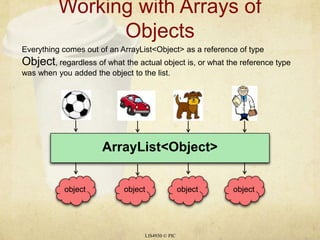
11 interfaces
- 1. Working with Arrays of Objects LIS4930 © PIC Everything comes out of an ArrayList<Object> as a reference of type Object, regardless of what the actual object is, or what the reference type was when you added the object to the list. ArrayList<Object> object object object object
- 2. What’s the Issue? LIS4930 © PIC What type of object reference is the Practice array? What classes are these methods in? The compiler decides whether you can call a method based on the reference type, not the actual object type.
- 3. Get in touch with your inner Object. LIS4930 © PIC Object equals() getClass() hashCode() toString() Doctor treatPatient() FamilyDoctor giveAdvice() There is ONE object on the heap here. A FamilyDoctor object. But it contains both the FamilyDoctor class parts of itself, the Doctor class parts, and the Object class parts of itself. FamilyDoctor object
- 4. ‘Polymorphism’ means ‘many forms’ LIS4930 © PIC FamilyDoctor D = new FamilyDoctor(); D Object F = D; F The object reference can see ONLY the Object parts of the FamilyDoctor object. It can access only the methods of class Object. FamilyDoctor object
- 5. Casting an Object reference back to its real type. LIS4930 © PIC F FamilyDoctor N = (FamilyDoctor) F; N It’s still really a FamilyDoctor object, but if you want to call FamilyDoctor specific methods, you need a reference declared as type FamilyDoctor FamilyDoctor object
- 6. Instanceof LIS4930 © PIC If you’re not sure it’s a FamilyDoctor, you can use the instanceofoperator to check. Because if you’re wrong when you do the cast, you’ll get a ClassCastException at runtime and come to a grinding halt.
- 7. LIS4930 © PIC Turn in your Textbooks. Look at page 219 – 223 in the textbook
- 8. Interface To The Rescue LIS4930 © PIC A Java interface solves your multiple inheritance problem by giving you much of the polymorphic benefits of multiple inheritance without the pain and suffering from the Deadly Diamond of Death (DDD). To make a Java interface you MUST make all the methods abstract! Use the keyword “implements” followed by the interface name. Note that when you implement an interface you still get to extend a class Pet abstract void beFriendly() abstract void play() abstract void eat() To DEFINE an interface: public interface Pet { … } To IMPLEMENT an interface: public class Dog extends Canine implements Pet { … }
- 9. Building Interfaces LIS4930 © PIC You say ‘interface’ instead of ‘class’ here public interface Pet { public abstract void beFriendly( ); public abstract void play( ); } All interface methods are abstract, so they MUST end in semicolons. You say ‘implements’ followed by the name of the interface. You MUST give the methods a body here since they are abstract in the superclass. public class Dog extends Canine implements Pet { public void beFriendly( ) { … } public void play( ) { … } public void roam( ) { … } public void eat( ) { … } }
- 10. Classes from different inheritance trees can implement the same interface. LIS4930 © PIC Look at page 226 in the textbook When you use a classas a polymorphic type the objects you can stick in that type must be from the same inheritance tree. But when you use an interfaceas a polymorphic type (like an array of Pets), the objects can be from anywhere in the inheritance tree. The only requirement is that the object are from a class that implements the interface. A class can implement multiple interfaces: public class Dog extends Animal implements Pet, Saveable, Paitable { … }
- 11. How do you know whether to make a class, a subclass, an abstract class, or an interface? LIS4930 © PIC Make a class that doesn’t extend anything (other than Object) when your new class doesn’t pass the IS-A test for any other type. Make a subclass (extend a class) only when need to make a more specific version of a class and need to override or add new behaviors. Use an abstract class when you want to define a templatefor a group of subclasses, and you have at least some implementation code that all subclasses could use. Make the class abstract when you want to guarantee that nobody can make objects of that type. Use an interface when you want to define a role that other classes can play, regardless of where those classes are in the inheritance tree.
- 12. Invoking Superclass Methods LIS4930 © PIC The keyword superlets you invoke a superclass version of an overridden method, from within the subclass Look at page 228 in the textbook